Overnight, Refrigerator Focaccia = The Best Focaccia Bread Recipe
This post may contain affiliate links. Please read my disclosure policy.
Cold, refrigerated dough is the secret to making delicious focaccia! Allowing the dough to rest 18 to 48 hours in the fridge will yield extra-pillowy and airy focaccia, though if you are pressed for time, you can make this start-to-finish in 3 hours. This 4-ingredient recipe requires only 5 minutes of hands-on time. Video guidance below!
⭐️⭐️⭐️⭐️⭐️ Review:
“Love this recipe! I’ve made this so many times that I’ve lost count. Super simple and delicious. My family loves it. Whenever someone asks me for a focaccia recipe, I always show them this one. This recipe is awesome. Thank you for sharing!” — Lucy
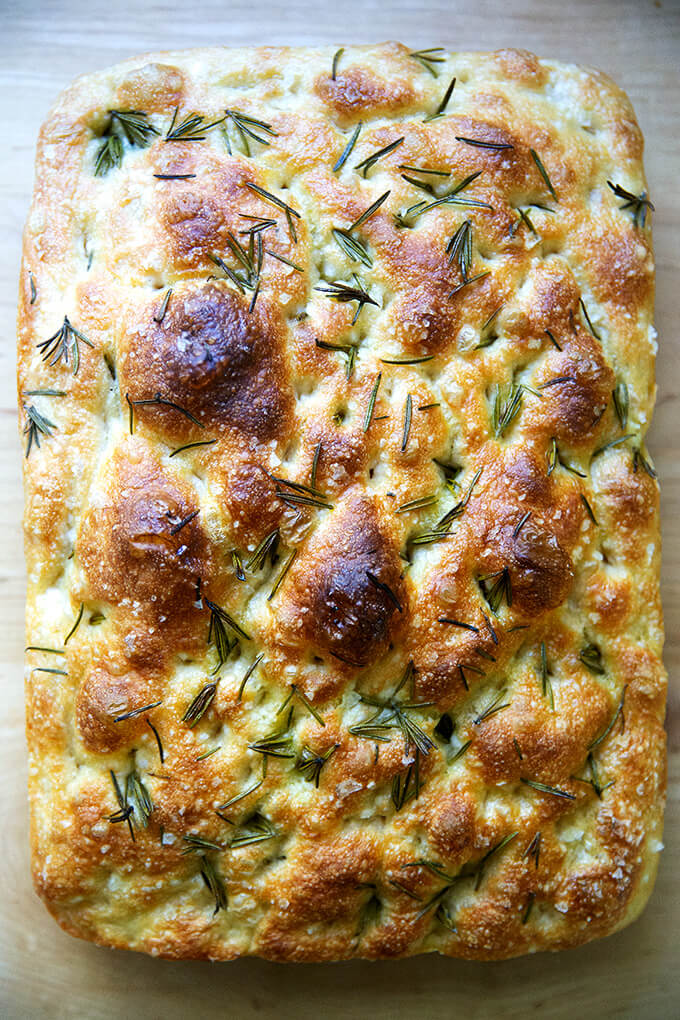
I’ve said it before and I’ll say it again: focaccia is the bread recipe for beginners. Why? Because:
- The no-knead, 4-ingredient dough takes 5 minutes to mix together.
- It requires no special equipment, no tricky shaping technique, and no scoring.
- If you have a 9×13-inch baking pan and your fingertips (for dimpling), you’re good to go.
- It emerges soft and pillowy, olive oil-crusted, golden all around, and it’s completely irresistible.
In sum, it’s hard to beat focaccia (pronounced foh-kah-chuh) in the effort-to-reward category. If you are intimidated by bread baking, this is the recipe I suggest making first, both for its simplicity and flavor. After all, this focaccia bread recipe is adapted from my mother’s simple peasant bread recipe, a recipe that has removed the fear of the bread baking process for many.
For the past few months, I’ve been making the focaccia bread recipe from my cookbook Bread Toast Crumbs, but changing the method: using more yeast, using less yeast, doing longer, slower rises at room temperature, doing longer, slower rises in the refrigerator. Find the results below.
This post is organized as follows:
- What Makes The Best Focaccia
- Four Tips for Success
- How This Focaccia Recipe Differs from Others
- Focaccia Bread Ingredients
- How to Make Focaccia, Step by Step
- Adding Rosemary, Herbs and Other Toppings to your Focaccia Dough
- How to Make a Focaccia Bread Art
- Tomato Focaccia
- How to Make a Focaccia Bread Sandwich
- Can I Skip the Overnight Rise?
PS: Once you master this simple focaccia, try your hand at this simple sourdough bread recipe, another recipe that requires minimal effort but yields spectacular results.
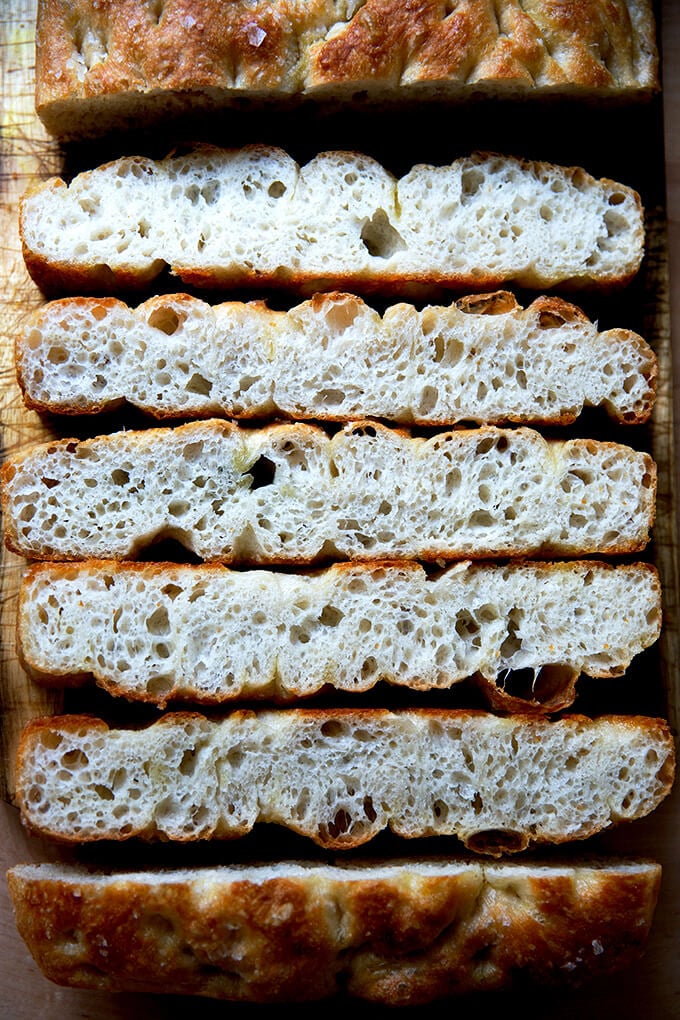
What Makes The Best Focaccia?
I’ll spare you all the details of the various experiments and skip straight to what I’ve found creates the best focaccia, one that emerges golden all around, looking like a brain, its surface woven with a winding labyrinth of deep crevices: high-hydration, refrigerated dough.
This is nothing novel—many bakers extol the virtues of the cold fermentation process—and it came as no surprise to me either: it was, after all, past-prime Jim Lahey refrigerated dough that showed me how easy focaccia could be: place cold, several-days-old pizza dough in a well-oiled pan, let it rise for several hours or until it doubles, drizzle with more oil, dimple with your fingers, sprinkle with sea salt, then bake until done.
Employing a refrigerator rise requires more time because the cold environment slows everything down initially, and during the second rise, the cold dough takes time to warm to room temperature. The overall effort, however, is very hands-off, and the result — a light, airy, pillowy dough — is well worth it.
As important as refrigerating the dough is using a high hydration dough, meaning a dough with a high proportion of water relative to the flour. The high proportion of water will create a dough with beautiful air pockets throughout. (Incidentally, this is the secret to making excellent pizza dough as well as light, airy sourdough sandwich bread.)
How This Focaccia Recipe Differs from Others
There are lots of focaccia bread recipes out there, so why make this one? This one differs from many of the recipes out there in two ways:
- The long, cold, refrigerator rise.
- The absence of sugar or honey or any sort of sweetener.
Why isn’t there any sweetener in this recipe? Simply stated, a sweetener is just not needed — the yeast, contrary to popular belief, does not need sugar to activate or thrive. Sugar will speed things up, but when you’re employing a long, slow rise, speed is not the name of the game.
Moreover, and this is getting a little scientific, but during the long, cold fermentation: enzymes in both the flour and the yeast will break down the starches in the flour into simple sugars, which will contribute both to flavor and to browning, again rendering sugar unnecessary. Cool, right?
Four Tips for Success
- Allowing the dough to rest 18 to 24 hours in the fridge yields the best results. (You can leave the dough in the fridge for as long as 72 hours.)
- A buttered or parchment-lined pan in addition to the olive oil will prevent sticking. When I use Pyrex or other glass pans, butter plus oil is essential to prevent sticking. When I use my 9×13-inch USA Pan, I can get away with using olive oil alone.
- Count on 2 to 4 hours for the second rise. This will depend on the temperature of your kitchen and the time of year.
- After the second rise, dimple the dough, then immediately stick the pans in the oven — this has been a critical difference for me in terms of keeping those desirable crevices. If you dimple and let the dough rise again even for 20 minutes before popping the pan in the oven, the crevices begin to dissolve.
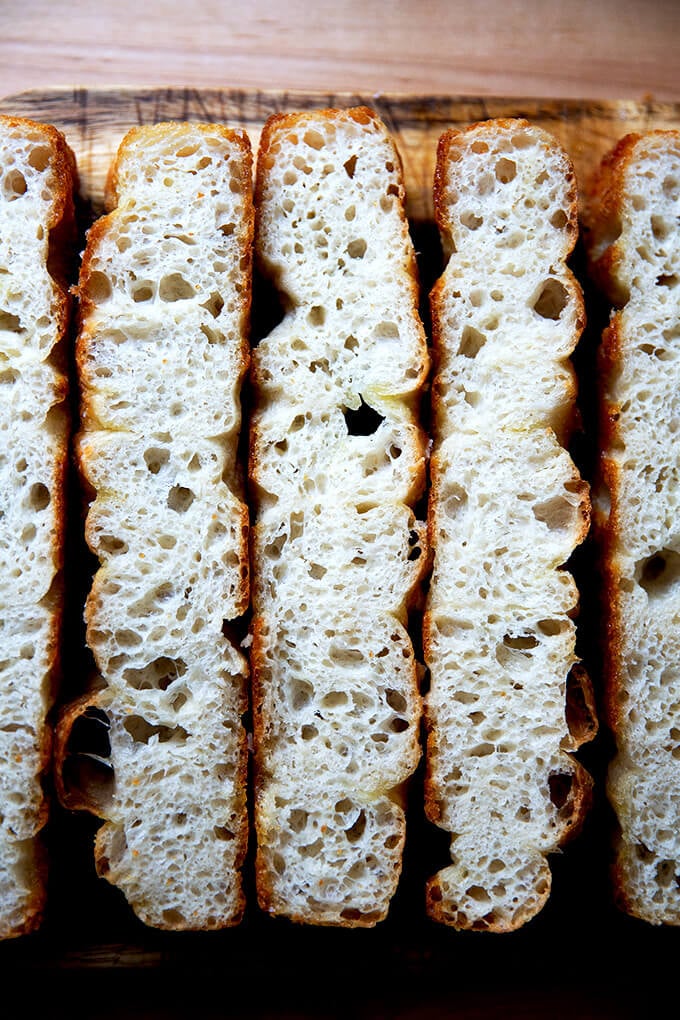
Ingredients
- Flour: bread flour or all-purpose flour will work equally well here. If you live in a humid environment or abroad, I suggest trying to get your hands on bread flour. King Arthur Flour is my preference.
- Yeast: SAF Instant Yeast is my preference, but active dry yeast works just as well. See recipe box for instructions on how to use active-dry yeast in place of instant.
- Salt: I say this all the time, but a big part of making a good loaf of bread comes down simply to using the right amount of salt given the amount of flour you are using by weight. It’s like anything: bread has to be well seasoned. At a minimum, use 10 grams (2 teaspoons) of salt for every 500 grams (4 cups) of flour. I highly recommend investing in some good, flaky sea salt for sprinkling on top of the focaccia dough — it tastes better than the more finely ground varieties of salt. I use Diamond Crystal kosher salt for the dough, but any salt you have on hand will work just fine for the dough.
- Water: There is a lot of water in this dough — it’s 88% hydration — and all of that water helps produce a light, airy, pillowy dough.
- Olive oil: Olive oil both in the bottom of the pan and on top of the dough is essential for encouraging nice browning, flavor, and that quintessential oiliness we all love about focaccia.
- Rosemary or other seasonings: Rosemary is a classic focaccia topping, and you can either sprinkle it over the dough before baking or you can chop it up and add it to the dough. Many people love sun-dried tomatoes and olives in their focaccia. See below for how to incorporate these other ingredients into your focaccia dough.
How to Make Focaccia Bread, Step by Step
Gather your ingredients: 4 cups (512 g) flour, 2 teaspoons (10 g) salt, 2 teaspoons (8 g) instant yeast (SAF is my preference), 2 cups (455 g) water:
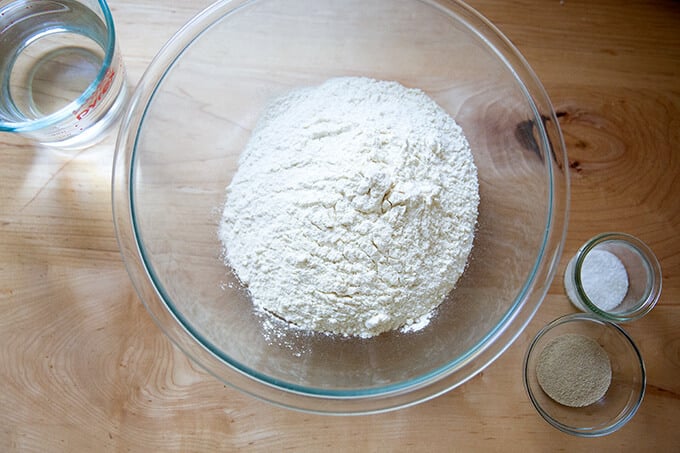
Whisk together the flour, salt, and yeast first:
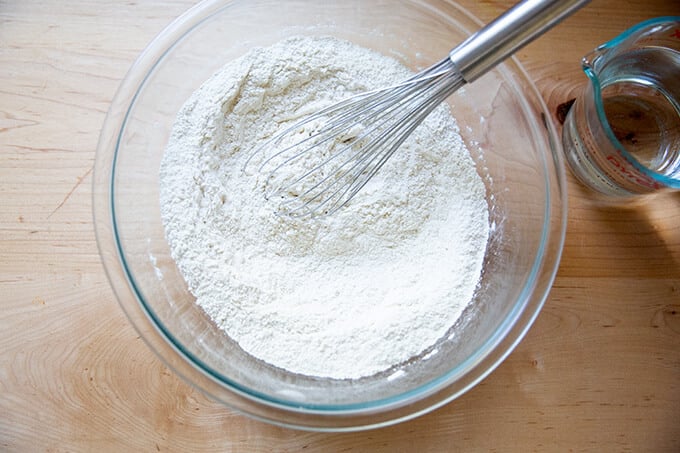
Add the water:
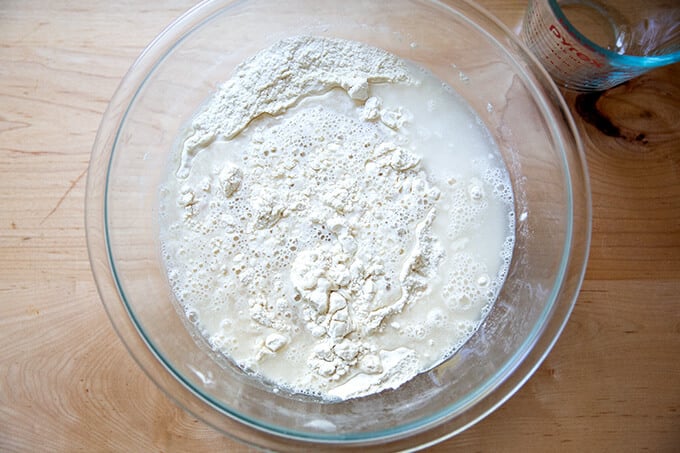
Use a spatula to stir the two together.
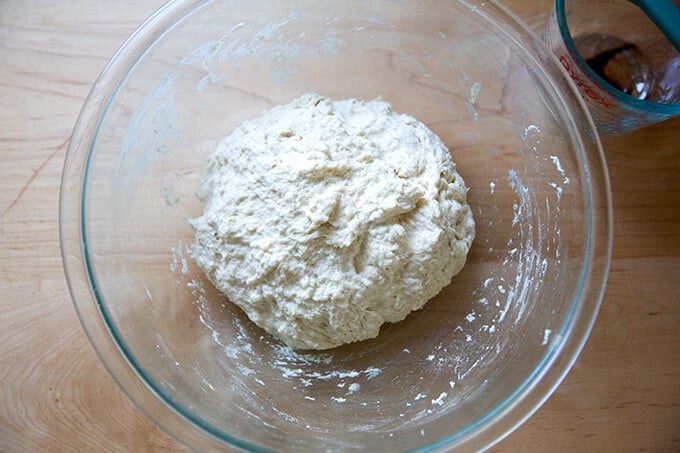
Slick the dough with olive oil:
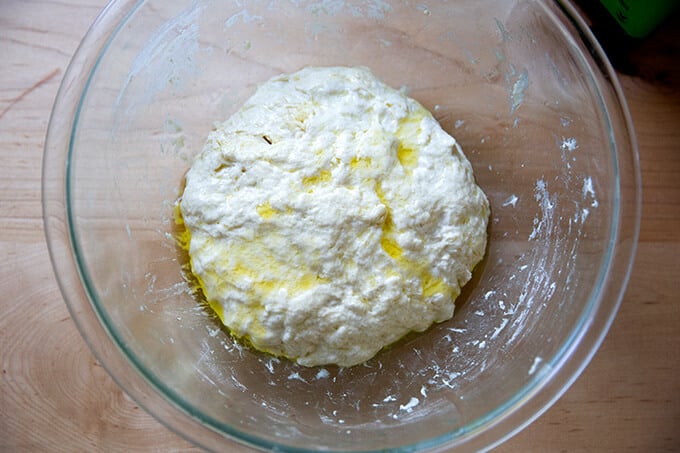
Slick the surface of the dough with olive oil; then cover the bowl. You all have one of these, right? Stick the bowl in the fridge immediately; leave it there to rise for 12 to 18 hours (or longer—I’ve left it there for as long as three days). NOTE: It is important the dough really be slicked with olive oil especially if you are using a cloth bowl cover or tea towel as opposed to plastic wrap or the lid pictured in the photo below this one. If you are using a tea towel, consider securing it with a rubber band to make a more airtight cover. If you do not slick the dough with enough oil, you risk the dough drying out and forming a crust over the top layer.
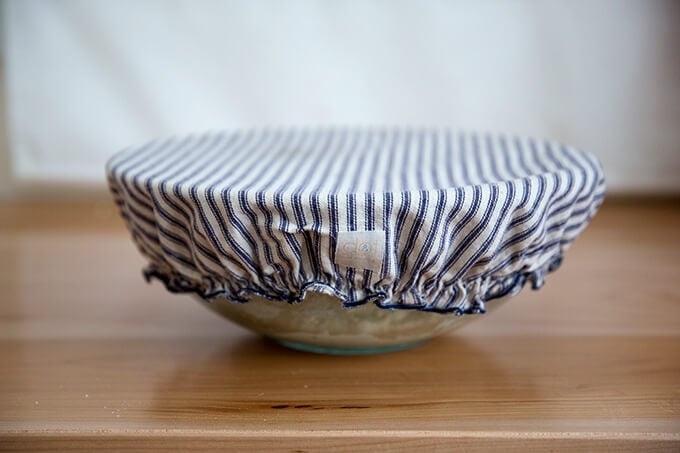
Another option: the lid that comes with the 4-Qt Pyrex bowl. This is handy for fridge storage because you can stack things on top of it.
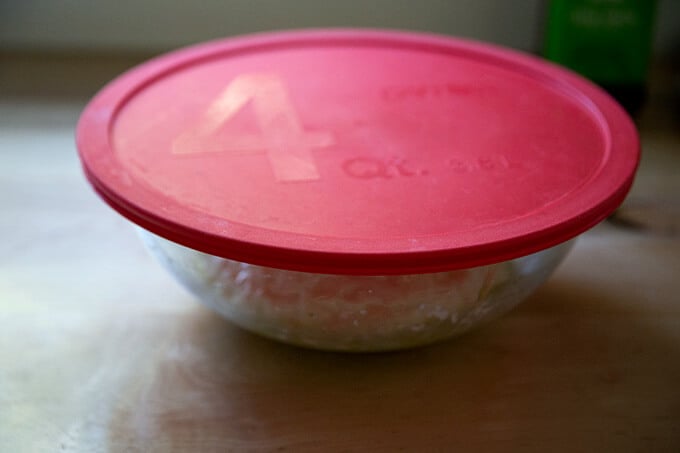
Remove from fridge, and remove the cover:
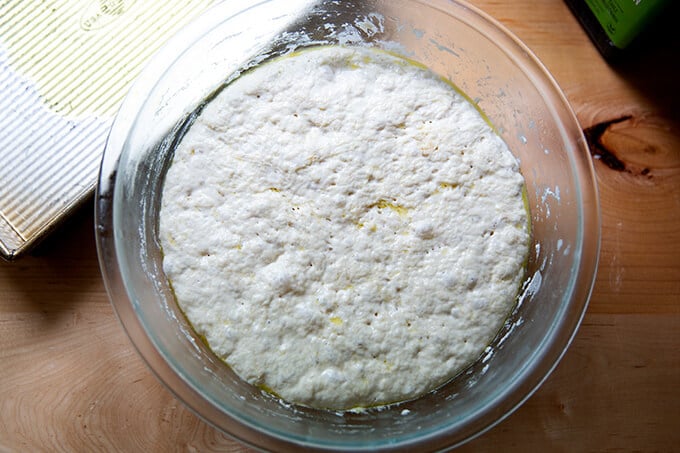
Deflate the dough and transfer to a prepared pan. I love this 9×13-inch USA pan. If you don’t have one you can use two 8- or 9-inch pie plates or something similar. If you are using glass baking dishes be sure to grease the dishes with butter before pouring a tablespoon of olive oil into each. (The butter will ensure the bread doesn’t stick.) Don’t touch the dough again for 2 to 4 hours depending on your environment.
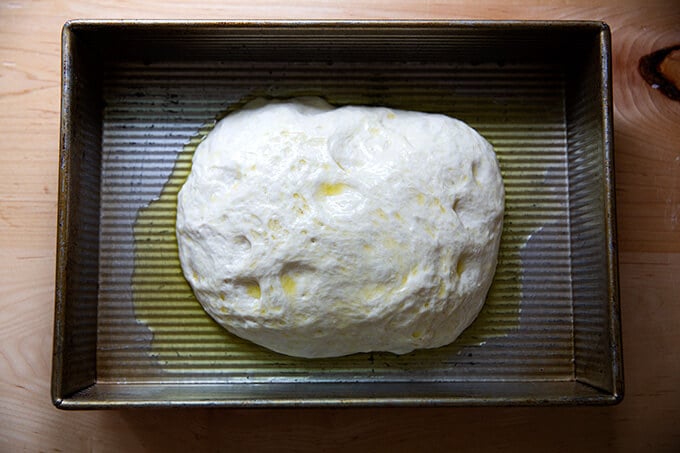
After two to four hours, or when the dough looks like this…:
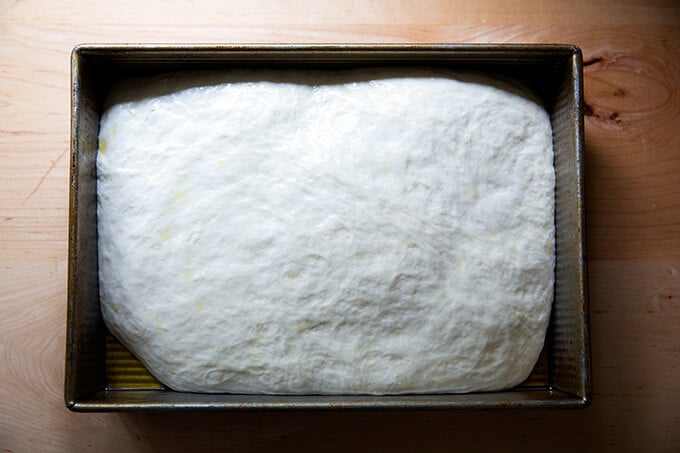
… it’s time to dimple it! You can use simply olive oil and salt — I recommend good, flaky sea salt for this. Note, the dough in the photo below spent three days in the fridge, and the dough was super bubbly!
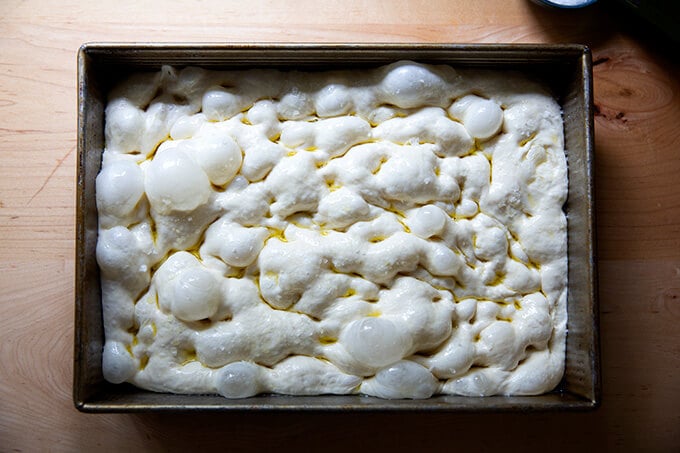
if you are using rosemary, sprinkle it over the dough. Then pour two tablespoons of olive oil over the dough, and using your fingers, press straight down to create deep dimples. Sprinkle with flaky sea salt — again, something like Maldon is great here.
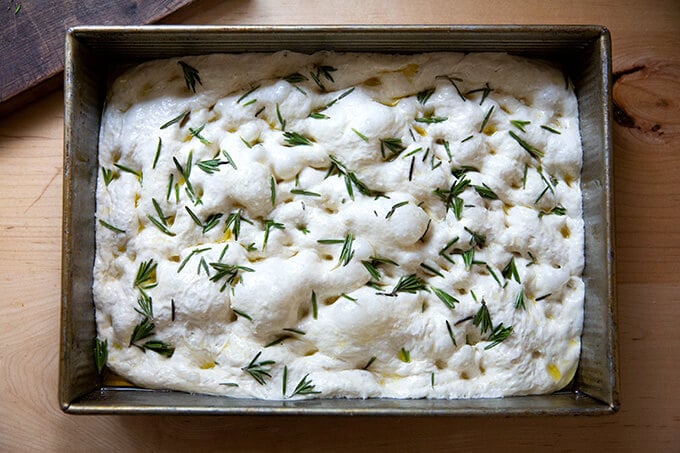
Transfer to oven immediately and bake at 425ºF for 25 minutes or until golden all around. Remove focaccia from pans and place on cooling racks.
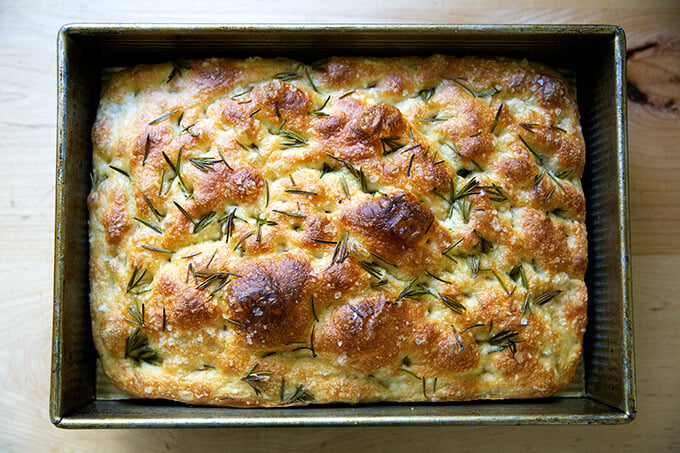

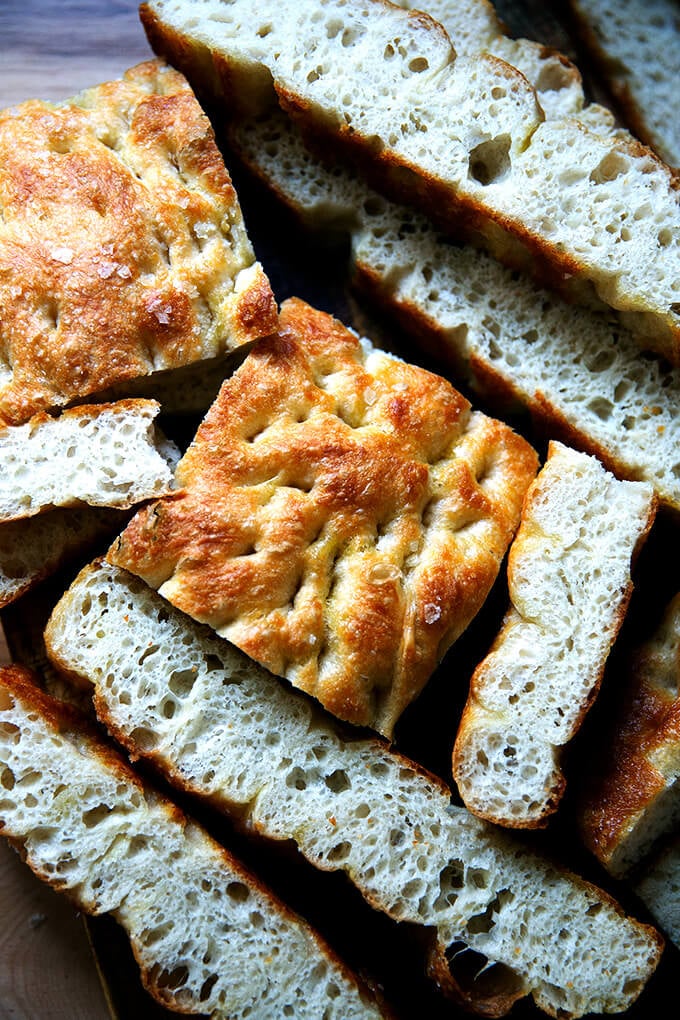
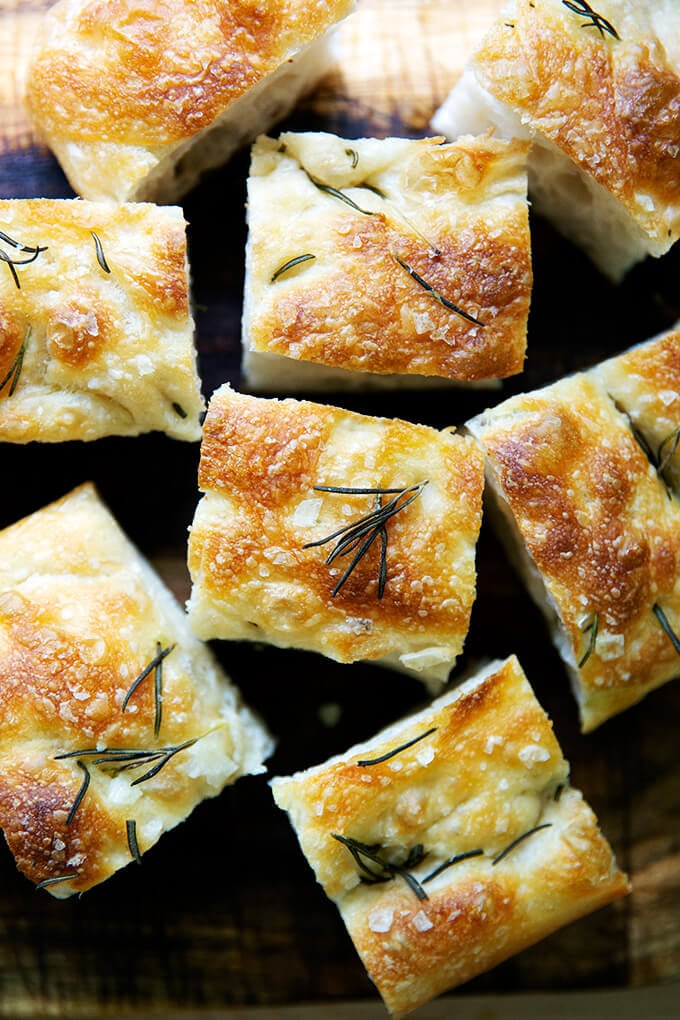
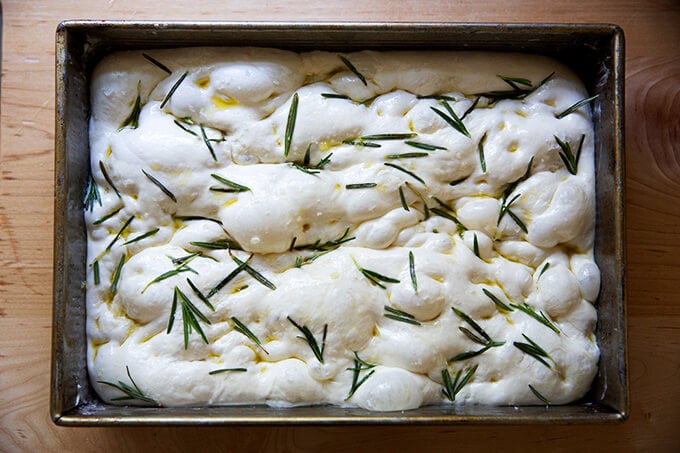
How to Incorporate Rosemary, Herbs, and Other Ingredients & Toppings into Your Focaccia Dough
One of the most frequently asked questions I get is: How can I add other toppings or ingredients to my focaccia bread? You can do this in two ways:
- Add them on top as you would rosemary or other herbs. The key is to make sure the ingredients are slicked lightly with olive oil to ensure they do not burn in the oven. I like to sprinkle the rosemary over top of the dough, then drizzle it with olive oil, then dimple the dough.
- You can add them directly to the dough. In step one, when you whisk together the flour, salt, and instant yeast, add your ingredients — chopped olives, sun-dried tomatoes, roasted garlic — to the flour and toss to coat; then add the water.
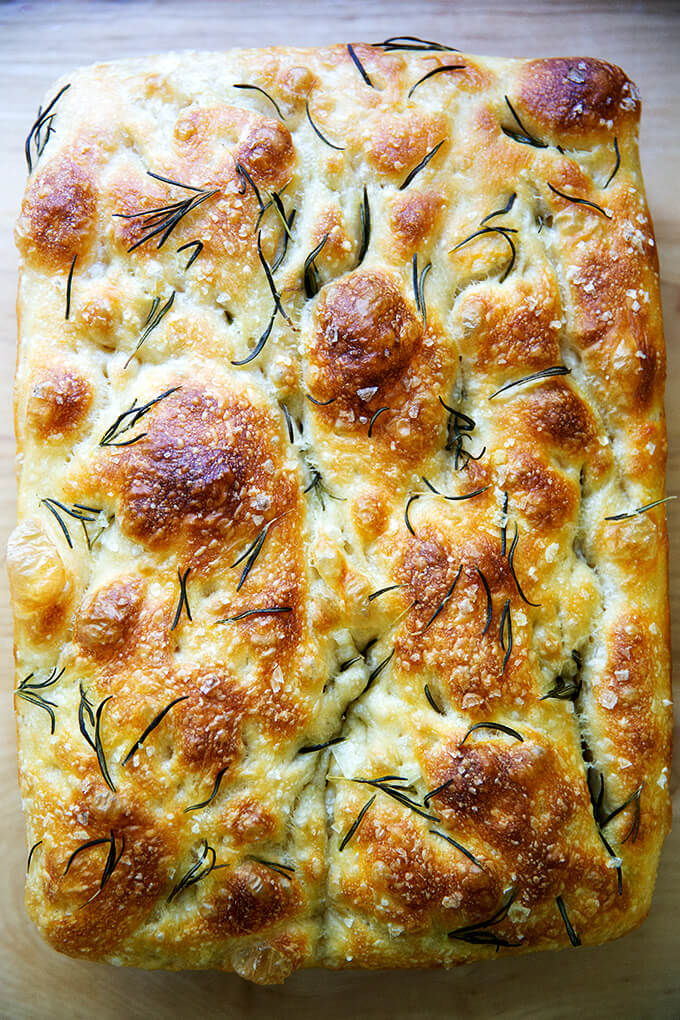
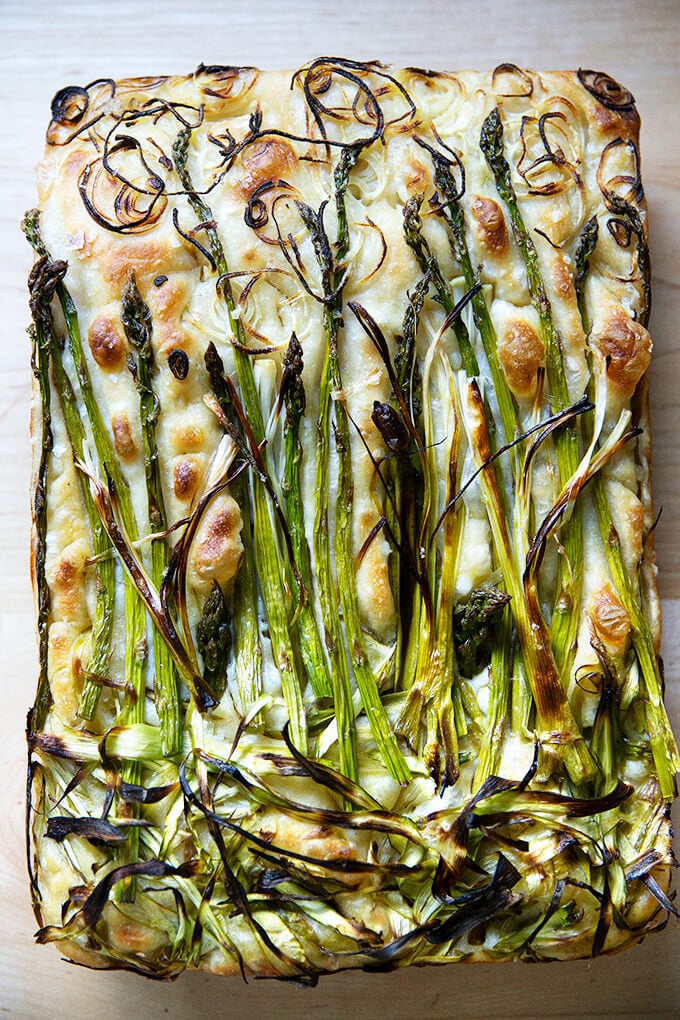
How to Make a Focaccia Bread Art
Pictured above is my “Ode to Spring” (🤣) Focaccia Bread Art (or Garden Scape). As noted above, the key with adding toppings is to slick them lightly with olive oil to ensure they don’t completely char. Keep in mind that some items will char, and a little charring is not a bad thing.
To make a focaccia bread art:
- Follow the recipe through the step in which you dimple the dough just before baking. Arrange your toppings — sliced peppers, asparagus, scallions, olives, tomatoes, onions, etc. — over top and dimple again, pressing the ingredients into the dough to embed them — you can be more aggressive than you think.
- Brush the entire surface with olive oil; then sprinkle with sea salt.
- Bake as directed.
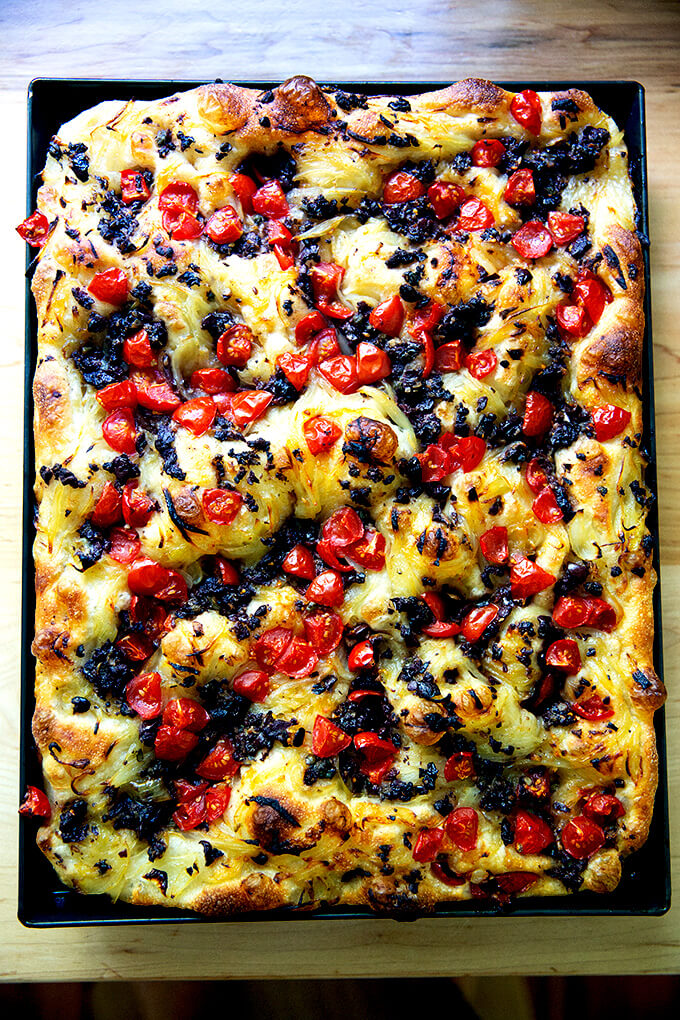
Tomato Focaccia
Pictured above is a cross between pissaladière and tomato focaccia. I love the addition of tomatoes to pissaladière because it adds a freshness and brightness, a hit of acidity to offset the sweet caramelized onions and salty anchovies, olives, and capers.
You can use any summer tomatoes you have on hand — diced cherry tomatoes, Roma, plum, sliced beefsteak tomatoes, heirloom tomatoes, etc. If you choose to dice up Roma or plum tomatoes, there is no need to seed them, but leave any juices lingering on the cutting board behind.
Top the unbaked focaccia with a thin layer of tomatoes; then bake as directed.
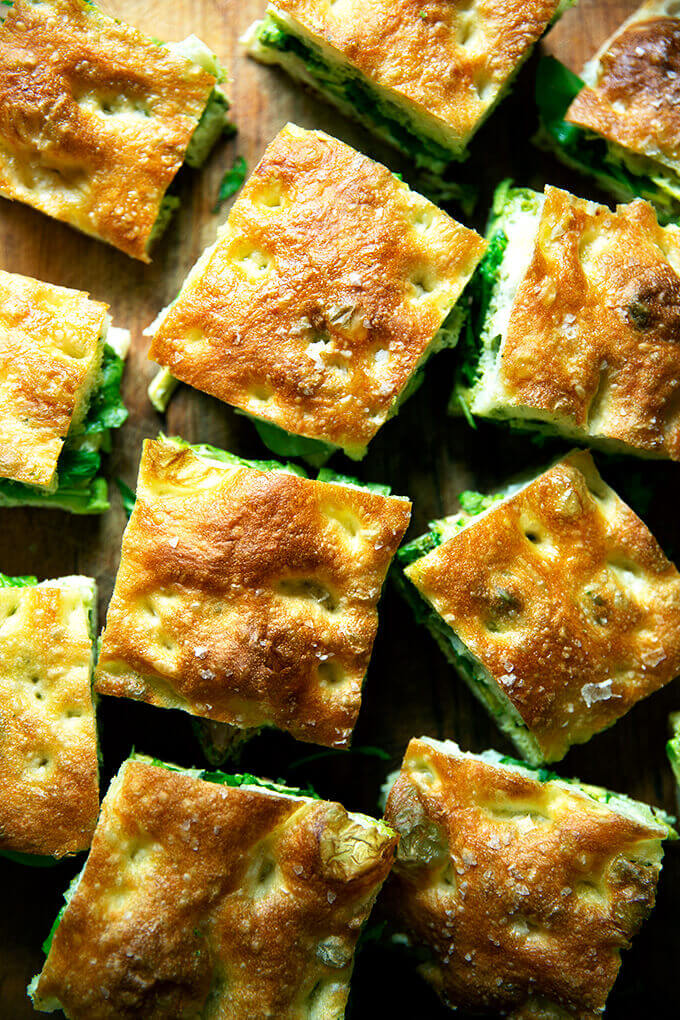
How to Make Focaccia Bread Sandwiches
One of my favorite things to do with either the rounds of focaccia or the 9×13-inch slab of focaccia is to make a giant sandwich: simply halve the whole finished loaf of focaccia in half crosswise; fill it as you wish, close the sandwich; then slice and serve.
Here’s one of my favorites: Roasted Red Peppers, Olive Tapenade, & Whipped Honey Goat Cheese
Can I Make this Overnight Focaccia Without the Overnight Rise?
Yes, you can. In fact, in my cookbook, Bread Toast Crumbs, I do not employ an overnight rise. Start-to-finish it can be made in about three hours. The finished bread will not be as pillowy, but it will still be light, airy, and delicious.
To skip the overnight rise, simply let the mixed dough rise at room temperature until doubled, about 1.5 to 2 hours. Then proceed with the recipe, knowing the second rise will only take about 30 minutes.
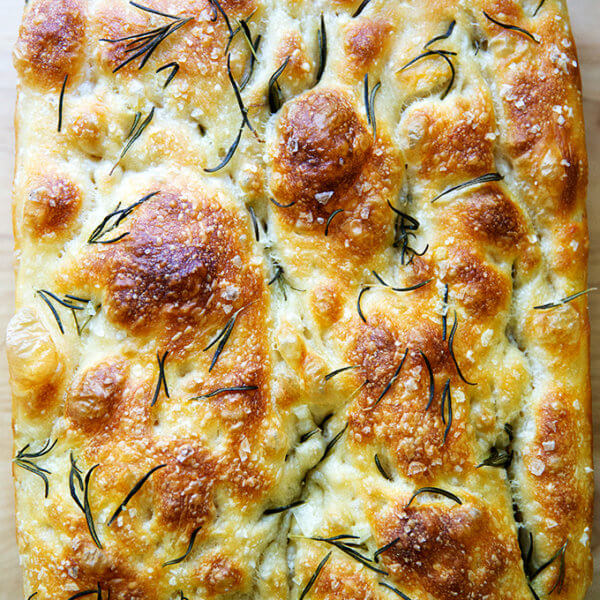
The Best, Easiest Focaccia Bread Recipe
- Total Time: 18 hours 30 minutes
- Yield: 2 loaves
Description
Cold, refrigerated dough is the secret to making delicious focaccia! Allowing the dough to rest 18 to 24 hours in the fridge will yield extra-pillowy and airy focaccia, though if you are pressed for time, you can make this start-to-finish in 3 hours. This 4-ingredient recipe requires only 5 minutes of hands-on time. Video guidance below!
Adapted from the focaccia recipe in Bread Toast Crumbs.
A few notes:
- Plan ahead: While you certainly could make this more quickly, it turns out especially well if you mix the dough the day before you plan on baking it. The second rise, too, takes 2 to 4 hours.
- If you are short on time and need to make the focaccia tonight: Let the mixed dough rise at room temperature until doubled, about 1.5 to 2 hours. Then proceed with the recipe, knowing the second rise will only take about 30 minutes.
- You can use various pans to make this focaccia such as: two 9-inch Pyrex pie plates. (Use butter + oil to prevent sticking.) One 9×13-inch pan, such as this USA pan — do not split the dough in half, if you use this option, which will create a thicker focaccia . A 13×18-inch rimmed sheet pan — this creates a thinner focaccia, which is great for slab sandwiches.
- As always, for best results, use a digital scale to measure the flour and water.
- I love SAF instant yeast. I buy it in bulk, transfer it to a quart storage container, and store it in my fridge for months. You can store it in the freezer also.
- If you are using active-dry yeast, simply sprinkle the yeast over the lukewarm water and let it stand for 15 minutes or until it gets foamy; then proceed with the recipe.
- Flour: You can use all-purpose or bread flour here with great results. If you live in a humid environment, I would suggest using bread flour. If you are in Canada or the UK, also consider using bread flour or consider holding back some of the water. Reference the video for how the texture of the bread should look; then add water back as needed.
Ingredients
- 4 cups (512 g) all-purpose flour or bread flour, see notes above
- 2 teaspoons (10 g) kosher salt
- 2 teaspoons (8 g) instant yeast, see notes above if using active dry
- 2 cups (455 g) lukewarm water, made by combining 1/2 cup boiling water with 1 1/2 cups cold water
- butter for greasing
- 4 tablespoons olive oil, divided
- flaky sea salt, such as Maldon
- 1 to 2 teaspoons whole rosemary leaves, optional
Instructions
- Make the dough: In a large bowl, whisk together the flour, salt, and instant yeast. Add the water. Using a rubber spatula, mix until the liquid is absorbed and the ingredients form a sticky dough ball. Rub the surface of the dough lightly with olive oil. Cover the bowl with a damp tea towel, cloth bowl cover, or plastic wrap and place in the refrigerator immediately for at least 12 hours or for as long as three days. (See notes above if you need to skip the overnight rise for time purposes.) NOTE: It is important the dough really be slicked with olive oil especially if you are using a cloth bowl cover or tea towel as opposed to plastic wrap or a hard lid. If you are using a tea towel, consider securing it with a rubber band to make a more airtight cover. If you do not slick the dough with enough oil, you risk the dough drying out and forming a crust over the top layer.
- Line two 8- or 9-inch pie plates or a 9×13-inch pan (see notes above) with parchment paper or grease with butter or coat with nonstick cooking spray. (Note: This greasing step may seem excessive, but with some pans, it is imperative to do so to prevent sticking. With my USA pans, I can get away with olive oil alone; with my glass baking dishes, butter is a must.)
- Pour a tablespoon of oil into the center of each pan or 2 tablespoons of oil if using the 9×13-inch pan. Using two forks, deflate the dough by releasing it from the sides of the bowl and pulling it toward the center. Rotate the bowl in quarter turns as you deflate, turning the mass into a rough ball. Use the forks to split the dough into two equal pieces (or do not split if using the 9×13-inch pan). Place one piece into one of the prepared pans. Roll the dough ball in the oil to coat it all over, forming a rough ball. Repeat with the remaining piece. Let the dough balls rest for 3 to 4 hours depending on the temperature of your kitchen (Note: no need to cover for this room temperature rise).
- Set a rack in the middle of the oven and preheat it to 425°F. If using the rosemary, sprinkle it over the dough. Pour a tablespoon of oil over each round of dough (or two tablespoons if using a 9×13-inch pan). Rub your hands lightly in the oil to coat, then, using all of your fingers, press straight down to create deep dimples. If necessary, gently stretch the dough as you dimple to allow the dough to fill the pan. Sprinkle with flaky sea salt all over.
- Transfer the pans or pan to the oven and bake for 25 to 30 minutes, until the underside is golden and crisp. Remove the pans or pan from the oven and transfer the focaccia to a cooling rack. Let it cool for 10 minutes before cutting and serving; let it cool completely if you are halving it with the intention of making a sandwich.
- Prep Time: 18 hours
- Cook Time: 30 minutes
- Category: Bread
- Method: Oven
- Cuisine: Italian
This post may contain affiliate links. Please read my disclosure policy.

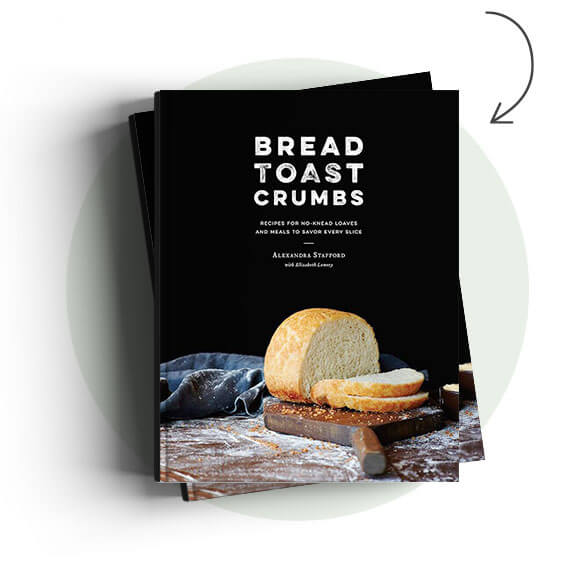

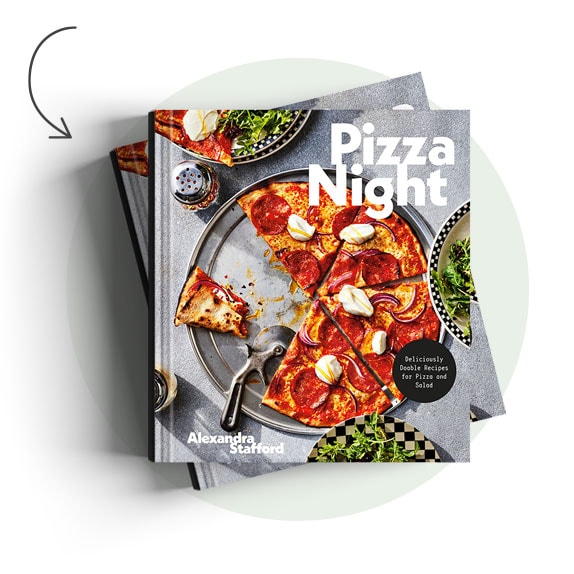


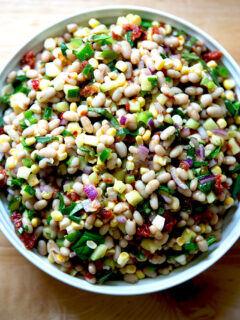
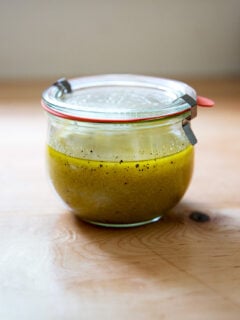
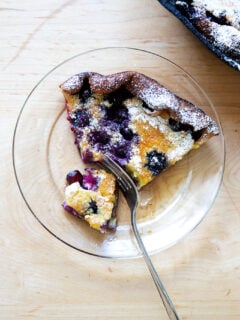


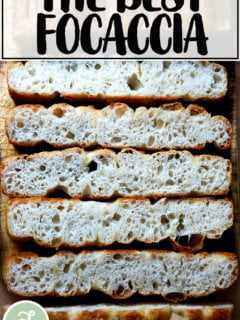
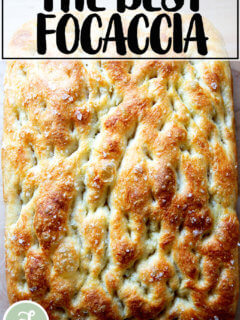
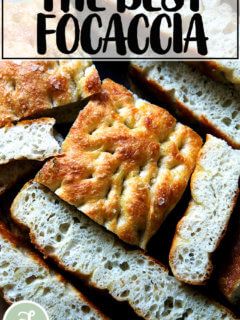
4,117 Comments on “Overnight, Refrigerator Focaccia = The Best Focaccia Bread Recipe”
Fantastic! I’ve made a lot of bread over the years but never what would be considered Artisan. This tastes that way to me!! The flavor development from the slow cold rise and the oil is like nothing else I’ve made. It got great color and crunch but springy and soft inside. I needed to get more color to the bottom so I put it on a lower rack after the top was sufficiently browned.
Thank you for all the work you put into sharing your recipes. Blogging, recipe creating, and video taping takes far more work than I think most people realize. We get to share what you create without cost. Thank you!!!
Julia, you are too kind! Thank you for all of this. Means a lot 💕💕💕 And thank you for writing and sharing your experience.
Love love love this recipe and all the advice given about the yeast varietals and the pans to use. Thank you for helping my first go at focaccia be a success!
Great to hear, Kasey! Thanks so much for writing 🙂
This is a FABULOUS recipe! Best focaccia I have ever made! I would like to make a large batch, can this recipe be doubled? If so what are the ingredient adjustments? Thank you for your amazing recipes! Love your book and can’t wait for the pizza book!♥️
Excellent recipe. Lots of great tips for making a better loaf.
Hey Ali,
my dough is more liquidy than yours (and I measured exactly using a scale). My question: after taking the dough from the fridge and before transferring it to the pan for further rising, can I mix some more flour to make it less liquidy? Or would that destroy the process?
Thank you!
Hi! Have you made this once yet? I would make it once as directed and see how it turns out (so, in other words, don’t add more flour); then depending on your results, use less water from the start next time around. Depending on your environment and the type of flour you are using, the amount of water here might just be too much.
What type of flour are you using?
What a great recipe for a newbie! Delicious. My only error was to use a ceramic baking dish and not put quite enough butter on the bottom, so a little part stuck. Other than that user error, a 10/10 recipe.
Great to hear, Tan! Thanks so much for writing 🙂
Hi, I tried this, its excellent! Thanks!!
Any advice for using whole wheat (brown flour ) instead?
Hi! I would try subbing in 1 cup of whole wheat flour for the white flour first; then adjust with more or less after that depending on your results.
As easy as she says it is. I have made it several times and it always turns out perfectly.
Great to hear, Dave 🙂
Hello. First… thank u so much for this easy recipe. I just made it and it’s hanging out in the fridge for the next 2 or 3 days. However, just wanted to make sure that when it comes out of the fridge.. the next rise is to be done at room temperature correct? Thank u so much in advance.
Correct!
Good
I can’t remember if I’ve already commented on this recipe but I just made it again and felt the need to share how easy and delicious this recipe really is. I’m not a baker but everyone wants to know where I “bought” the bread and when I tell them the hardest part of this recipe is finding room in the fridge for 24 hours they don’t believe me until they try it. Thank you so much for this top notch recipe
So nice to hear this, Michelle! Thanks so much for writing and sharing all of this 🙂 🙂 🙂
This recipe totally rocks! I’ve made it at least a dozen times. I can devour an entire pie pan of it in two days! Lol…needing to gain weight though!
Great to hear, Judy! Thanks so much for writing 🙂
On the second rise (2-4 hours), should you cover it or not?
Thank you.
No need to cover it!
Although there is no need to cover it, will it cause any problems if I wanted to cover loosely with a flour sack towel on the second rise?
It will not cause any problems, go for it 🙂
Thank you! I will let you know how it turns out. This is my first attempt at Focaccia🙂
The Focaccia was great! I used bread flour and seasoned the top with Italian seasoning and sea salt. It had a wonderful texture and chew🙂
Great to hear, Deb! Thanks for reporting back 🙂
Made your recipe …again! Great recipe. I make half and bake in 9″ square USA pan.
Just a word on flour & weights.
I live in the NW, Bob’s Red Mill country. His flours ars good, accessible, and a great price, also can buy here in bulk. His flour weight chart is quite a bit different than KA. But his location is Portland which is very humid. I’m in central OR, 3800 ft, high & dry, which is quite different. So awhile ago I weighed out a cup of bread flour 3 times. Aerated, scoooped & leveled. My 1 cup bread flour is 128 g, and that is the weight I use.
The moral of this post…do some experimentation with the flour you use. Take into cosideration your climate & altitude. My climate is very dry. So I’m aware of how it affects my baking.
Thank you for your website & recipes. Looking forward to your pizza book.
P.S. …yes I do use a lot of Aveeno & sometimes EVOO!
Great to hear, PattiAnn! Thanks so much for writing and sharing all of this and encouraging others to experiment. I truly believe you cannot write a perfect bread recipe for all climates — because of humidity and variations in flour, every dough will turn out differently. Experimenting is so important! (As is using a scale :))
I’ve made this for all of my friends at this point, and many of them have said it’s the best focaccia they’ve ever had! Thank you for this incredible recipe, I can’t stop making this.
Great to hear, Claude! Thanks so much for writing 🙂
I just tried this recipe! I let it sit in the fridge for 20 hours, then let it sit at room temp for four hours. I put fresh rosemary and sea salt on top! It’s delicious. Crispy on the outside, pillowy on the inside. Ate it with wine braised short ribs. Going to make it again but use it as a pizza crust!!!! Amazing recipe!!
Yay! Great to hear, Caitlin 🙂 🙂 🙂 Thanks so much for writing and sharing your notes.
Addictive.
Fantastic.
I refrigerated ~60 hours.
Red onion & garden fresh rosemary..
Nom nom nom nom
…nom nom nom.
Yessssss 🙂 🙂 🙂
I LOVE this recipe! It’s my go-to focaccia recipe, super easy to follow and I love how you’ve really broken down the steps. My family can’t get enough of this focaccia whenever I make it, it’s basically always eaten in an instant.
I can’t imagine ever using a different focaccia recipe ever again! 10/10 🙂
Yay 🙂 🙂 🙂 Thanks so much, Fenella.
Delicious! So many possibilities for add–ins, spices, veggies etc.
Yay, great to hear 🙂 🙂 🙂
I NEVER comment on these recipe pages but I just had to today.
This recipe is one in a million.
As a decently knowledgeable baker/home cook I always adjust recipes to my own liking/instinct but I will admit this was my first time making focaccia and it was just… perfect. 👌🏻 so easy to follow, and everything about it from beginning to end was exactly how I was hoping it would be!
I topped mine with cherry tomatoes, freshly picked basil and garlic.
QUESTION: how do you typically store your leftovers ? Or if you’re giving some away, how would you store/transport it until then?
Thank you!
Great to hear! I store the bread at room temperature in an airtight bag, like a 2-gallon ziplock. I would do the same for transporting it, and definitely encourage whoever is receiving it to reheat it before eating it: 350ºF for 10-15 minutes will revive it.
Hi – this bread looks so yummy I can’t wait to make it. My question is I only have a glass 9×13 pan – will that matter ?
Thank you 😊
That will be fine! Be sure sure to butter it well before you add the olive oil.
Truly a perfect recipe. We make this regularly, including as a pizza dough. I think I am going to try using this for cinnamon rolls for Easter.
Great to hear Mandi! Thanks so much for writing 🙂 🙂 🙂
This bread is delicious with a wonderful, chewy crust. I included chopped, sun dried tomatoes on the top.
Great to hear, Cindy! Thanks so much for writing 🙂 🙂 🙂
I wish I could give this more than 5 stars. This recipe was SO easy to follow and it turned out better than I imagined. As a first time bread maker I was nervous but it couldn’t have turned out better (or more delicious). I’m so grateful to never have to buy focaccia from the grocery store ever again!
Thanks for taking the time to share this, and the other recipes on your site xx
Great to hear, Sara 🙂 🙂 🙂 Thanks so much for writing.
I was in a rush so I did a quick 2 hour rise then an hour more in the pan. But when you say Pyrex, do you mean a glass pan? I have it in my 9*13 glass Pyrex but I’m regretting that decision now that it’s in the oven. I think it takes longer when baking in a glass pan. Plus the oven can’t go oven 425 f. In the US I believe Pyrex is mostly glassware that can be used in the oven. Not sure if it’s like this everywhere else. But I’ll have to wait and see how this comes out. I’ve made the long version before and it was a nice success. Maybe it will be similar for this, shall see. Best
Pyrex or any oven-safe glass pan is fine!
Hi Ali, thank you for the recipe. I’m always looking out for the easiest recipes to try out and this focaccia recipe is not only easy, it turned out great! It’s humid here so I used bread flour and cold-ferment for 14hr, then proofed it at a slightly warm area of my kitchen for 2.5hr. My pan is almost the same size as yours so I stopped proofing when I saw that the dough had spread out like yours. Question: what if I use a different tray? You did mention that we can split into 2 smaller trays… How do we know that the dough is ready for the oven? The fact that the dough spreads out like this makes it more difficult to estimate (vs dough doubling in size when I made bread rolls)…
Hi! Great to hear. I find that 2.5-4 hours for the room temperature proof is about right and that it’s also very forgiving. If after 2.5 hours the dough still feels cold when you stretch it, and if it resists when you stretch it, it’s not ready. The dough should stretch easily when it’s ready.
Hi! I’m just reading your recipe for the first time and am going to try and make this. My one question is about the pan, I have either stone or cast iron pans. Would this effect how this is baked?
Those will work fine! As always, butter the pans well before adding the oil.
Fabulous recipe and notes! I have made this both over night and immediate rise. I even did some art! This has become a family favorite!
Great to hear, Katy! Thanks so much for writing 🙂
Fool proof focaccia recipe! Amazing results.
Great to hear, Cristina 🙂
So thrilled with how this recipe turned out! I’d never made focaccia before, and the resulting bread was scrumptious. Having all the extra information – and pictures! – was very helpful for me, as I kept worrying I was doing something wrong.
I made it for Easter, and had bought a package of brown & serve rolls as a backup, but didn’t need to use them. I had to bake it an extra 5 minutes, but the resulting bread was golden on top, just the right amount of crispness on the edge, and very light and fluffy inside. My mother loves focaccia and said it was some of the best she’s ever had.
I can’t wait to try different variations, and to see how it does when refrigerated for longer than just one day. I just used salt & rosemary today as my mother can’t have anything with garlic in it.
Thank you!
Great to read all of this, Misha! Thanks so much for writing and sharing your experience. Salt + rosemary is my favorite variation 🙂
Ohhh! I tried this recipe for our Easter dinner. I had some fun decorating it with olive “flowers”, onion and shallot “ flowers”, red and yellow pepper “flowers” and used green onions, basil and cilantro for stems and leaves and sprinkled on some rosemary as grass. It not only was extremely easy to make it was beyond delicious! We didn’t have a piece of it left. Thank you for sharing!
So nice to read this, Deb! I love a good focaccia garden 🙂 🙂 🙂 Thanks for sharing your “flower” notes.